Interesting Statistics Regarding Aches, Pains & Headaches
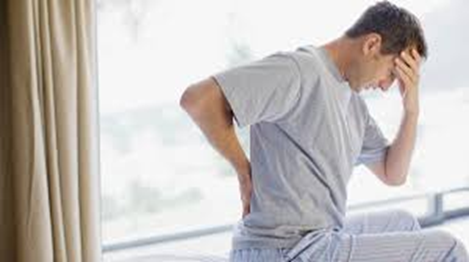 More than 51 million Americans experienced chronic pain in 2021 alone, according to CDC reports that analyzed data from the National Health Interview Survey. This staggering number represents 20.9% of the United States population.1
More than 51 million Americans experienced chronic pain in 2021 alone, according to CDC reports that analyzed data from the National Health Interview Survey. This staggering number represents 20.9% of the United States population.1- Of those, 17.1 million live with high-impact chronic pain that substantially restricts their ability to work or participate in daily activities.2
- The most common pain locations were back pain and hip, knee, or foot pain.3
- Headaches affect 90-99% of the population. 4% of the population say that they have never experienced a headache.4
Definition of Aches, Pains & Headaches
Pain is a signal in your nervous system that something may be wrong. It is an unpleasant feeling, such as a prick, tingle, sting, burn, or ache. Pain may be sharp or dull. It may come and go, or it may be constant. You may feel pain in one area of your body, such as your back, abdomen, chest, pelvis, head, or you may feel pain all over.
It’s important that our bodies can feel pain because pain can be helpful in diagnosing a problem. If you never felt pain, you might seriously hurt yourself without knowing it, or you might not realize you have a medical problem that needs treatment.5
A headache is pain in any region of the head. Headaches may occur on one or both sides of the head, be isolated to a certain location, radiate across the head from one point, or have a viselike quality.6
Causes of Aches, Pains & Headaches
Body aches and pain occur with many health conditions. If the pain lasts more than a few days, is severe, or occurs with other symptoms, you may need medical attention. Below are 17 potential causes for aches and pains.7
Stress - We often think of stress as a mental health condition, but it can also impact the body on a cellular level. In times of stress, the body can become more susceptible to infection and inflammation, and it may lead to aches and pain
Dehydration - Water is an essential ingredient for the body’s normal and healthy functioning. Without it, you can become dehydrated, which can lead to headaches and muscle cramps.
Lack of Sleep - Adults aged 18 and over need to sleep at least 7 hours in every 24 hours. Having too little sleep can make you more sensitive to pain. It can also worsen existing pain symptoms. Around 25% of your sleep should be the deepest sleep. During this time, the body repairs itself and releases essential hormones, among other functions.
Cold, flu, and COVID-19 - A cold, the flu, COVID-19, and other infections can cause inflammation as your immune system works to remove them. This can cause aches and pains. Cold symptoms are usually milder than those of the flu.
Anemia - Anemia happens when your body doesn’t have enough properly functioning red blood cells, so your body tissues can’t get enough oxygen. Some people who live with chronic conditions have anemia of chronic disease. Experts believe this may result when a chronic condition affects how the body works, including how it uses iron.
Vitamin D and calcium deficiency - Hypocalcemia, or a low blood calcium level, can happen when you don’t have enough calcium in your diet and vitamin D (calciferol) in your body from sunshine or your diet. Your bones and muscles need calcium and vitamin D to stay healthy.
Mononucleosis - Mononucleosis, mono, or “kissing disease” is an infection caused by the Epstein-Barr virus (EBV). It’s very contagious, and symptoms can include head and body aches.
Pneumonia - Pneumonia is a lung infection that can affect your whole-body causing body aches.
Fibromyalgia - - Fibromyalgia is a chronic condition where your entire body feels exhausted, achy, and sensitive. Why it happens is unclear, but older age and having lupus or rheumatoid arthritis seem to increase the risk.
Chronic Fatigue Syndrome - Syndrome (myalgic encephalomyelitis) - chronic fatigue syndrome (CFS), also called myalgic encephalomyelitis (ME), can cause you to feel exhausted and weak, no matter how much rest or sleep you get. Possible causes include previous infection with the EBV or other viruses, genetic factors, and changes in the immune system.
Arthritis - Pneumonia is a lung infection that can affect your whole-body causing body aches.
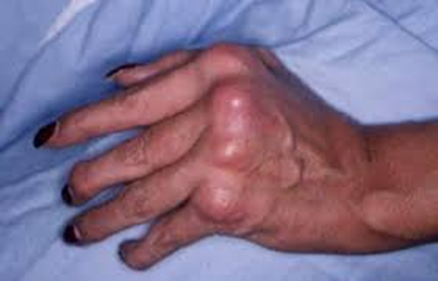 Osteoarthritis, which happens when the cartilage around your joints breaks down
Osteoarthritis, which happens when the cartilage around your joints breaks down- Autoimmune conditions that wear away the lining around your joints, such as rheumatoid arthritis (RA)
- Gout, when a buildup of uric acid crystals causes pain, swelling, and inflammation
- Psoriatic arthritis, which can occur with psoriasis and often involves swelling in the fingers
Lupus - Lupus, including systemic lupus erythematosus (SLE), happens when your immune system attacks the tissues around your body, including blood vessels, organs, and joints. The damage and inflammation can lead to pain in the joints due to arthritis.
Lyme disease - Lyme disease is a bacterial infection that spreads through tick bites. Symptoms develop in stages and include muscle pain, joint pain, especially in the knee, ankle, and wrist joints. Without treatment, Lyme disease can lead to neuromuscular and joint conditions, such as arthritis and facial paralysis. It can also cause heart problems.
Histoplasmosis - Histoplasmosis is a fungal infection caused by airborne spores from the soil or the droppings of bats or birds, especially in river valleys.
Multiple Sclerosis - Multiple Sclerosis (MS) is an autoimmune condition that affects the nervous system. It causes the myelin coverings around nerves to break down because of constant inflammation. As a result, the nerves cannot transmit messages effectively. As a result, a person with MS will experience body aches and pain.
Sepsis - Sepsis is an extreme response to an infection. It happens when an infection in the lungs, skin, kidneys, or elsewhere triggers an immune reaction throughout the body causing organ dysfunction. It is a life-threatening emergency because it can quickly lead to septic shock, which can be fatal.
Cancer - Cancer can cause general body pain if it spreads throughout the body or if a person has bone cancer. As late-stage cancer progresses, the pain will increase, and the person will need strong pain relief medication. Some cancer treatments can also cause bone pain. Anyone with cancer or a previous diagnosis of cancer should speak with a doctor if they notice an onset of general pain or bone pain.
Speaking of headaches specifically, most headaches aren't the result of a serious illness, but some may result from a life-threatening condition requiring emergency care.8 Headaches are generally classified by cause:
Primary Headaches
A primary headache is caused by overactivity of or problems with pain-sensitive structures in your head. A primary headache isn't a symptom of an underlying disease. Chemical activity in your brain, the nerves or blood vessels surrounding your skull, or the muscles of your head and neck (or some combination of these factors) can play a role in primary headaches. Some people may also carry genes that make them more likely to develop such headaches.
Some primary headaches can be triggered by lifestyle factors, including:
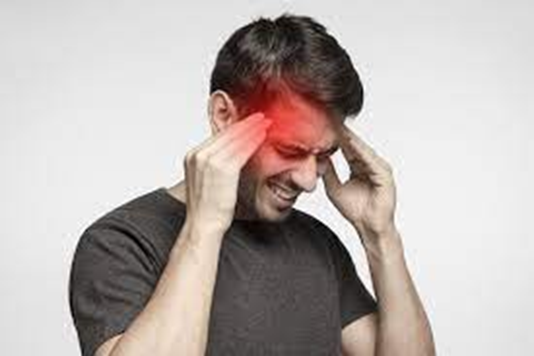 Depression and lack of desire to do the activities you once enjoyed
Depression and lack of desire to do the activities you once enjoyed- Alcohol, particularly red wine
- Caffeine
- Certain foods, such as processed meats that contain nitrates
- Poor posture
- Skipped meals / dieting
- Stress
Secondary Headaches
A secondary headache is a symptom of a disease that can activate the pain-sensitive nerves of the head. Any number of conditions — varying greatly in severity — may cause secondary headaches. Possible causes of secondary headaches include:
- Acute sinusitis
- Arterial tears (carotid or vertebral dissections)
- Blood clot (venous thrombosis) within the brain — separate from stroke
- Brain aneurysm
- Brain AVM (arteriovenous malformation)
- Brain tumor
- Carbon monoxide poisoning
- Chiari malformation (structural problem at the base of your skull)
- Concussion
- COVID-19
- Dehydration (when the body doesn't have enough water and other fluids to work as it should)
- Dental problems
- Ear infection (middle ear)
- Encephalitis (brain inflammation)
- Giant cell arteritis (inflammation of the lining of the arteries)
- Glaucoma (acute angle closure glaucoma)
- Hangovers

- High blood pressure (hypertension)
- Hormone levels changing
- Influenza (flu) and other febrile (fever) illnesses
- Intracranial hematoma
- Medications to treat other disorders
- Meningitis
- Monosodium glutamate (MSG)
- Overuse of pain medication
- Panic attacks and panic disorder
- Persistent post-concussive symptoms (Post-concussion syndrome)
- Pressure from tight headgear, such as a helmet or goggles
- Pseudotumor cerebri (idiopathic intracranial hypertension)
- Stroke
- Toxoplasmosis
- Trigeminal neuralgia (as well as other neuralgias, all involving irritation of certain nerves connecting the face and brain)
Symptoms of Aches, Pains & Headaches
Aches, pains and headaches are the clear symptoms we are discussing in this e-book. These aches and pains can be felt in one specific area of the body or all over the body depending on what issue one might be dealing with. Based on the potential causes of these aches and pains above, there are other symptoms to look out for.
Other symptoms of stress and anxiety include:
- an increased heart rate and blood pressure
- sweating
- hyperventilating
- trembling
- headache
Other symptoms of dehydration include:
- dark urine
- dizziness or disorientation
- exhaustion
- extreme thirst
 Not getting enough quality sleep also increase the risk of various chronic conditions, such as:
Not getting enough quality sleep also increase the risk of various chronic conditions, such as:
- diabetes
- cardiovascular disease
- obesity
- depression
Other symptoms of the cold, flu or COVID-19:
- sneezing
- stuffy nose
- sore throat
- fever and chills
- chest discomfort
- cough
- headache
- muscle and body aches
- cough and possibly breathing difficulty
- new loss of taste or sense of smell
- fatigue
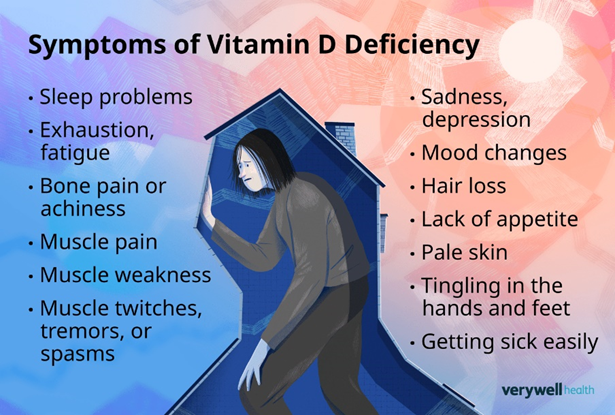 Other symptoms of anemia may include:
Other symptoms of anemia may include:
- body pain
- a rapid heart rate
- dizziness or light-headedness
- weakness and fatigue
- pale skin
- shortness of breath
Low vitamin D levels can lead to:
- bone pain and unusual bone shape in children and teens
- muscle pain and weakness
- muscle cramps
Other symptoms of Mononucleosis are:
- fatigue
- fever
- a sore throat
- swollen lymph nodes
- an enlarged liver, spleen, or both
- a rash
Pneumonia can cause chest and muscle pain, as well as:
- a cough, which may be dry or produce green, yellow, or blood-tinged mucus
- headache
- fever and chills
- breathing difficulty
- fatigue
- low appetite
- confusion
- nausea and vomiting, especially in children
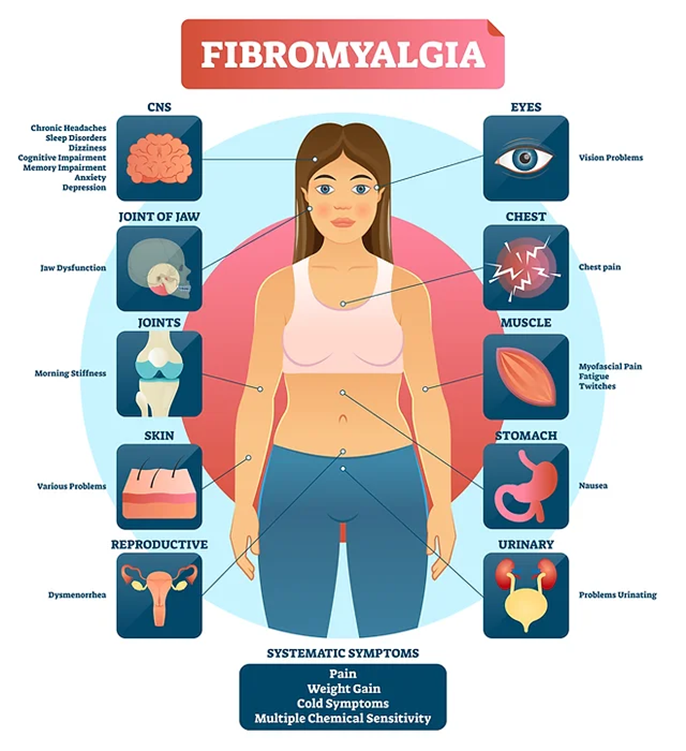 Fibromyalgia symptoms include:
Fibromyalgia symptoms include:
- pain and stiffness throughout the body
- fatigue
- depression and anxiety
- sleep problems
- difficulty thinking, focusing, and remembering
- headaches and migraine
Symptoms of Chronic Fatigue Syndrome (CFS) include:
- aches in the muscles and joints throughout your body
- fatigue that does not improve with rest
- a general feeling of being unwell
- headaches
- sleep disturbances and daytime drowsiness
- difficulty thinking and remembering
Other symptoms of arthritis include:
- stiffness in your joints
- swelling, warmth, or redness around the joint
- not being able to move a joint all the way
Other symptoms of Lupus include:
- skin lesions and rashes
- anemia
- headache
- heart, lung, and kidney problems
- ear and eye problems
Other symptoms of Lyme disease include:
- a rash
- eye pain
- facial palsy, or weakness in the facial muscles
Possible symptoms of Histoplasmosis include:
- flu-like symptoms
- chills and fever
- chest pain
- joint pain, in some cases
- headaches
- coughing
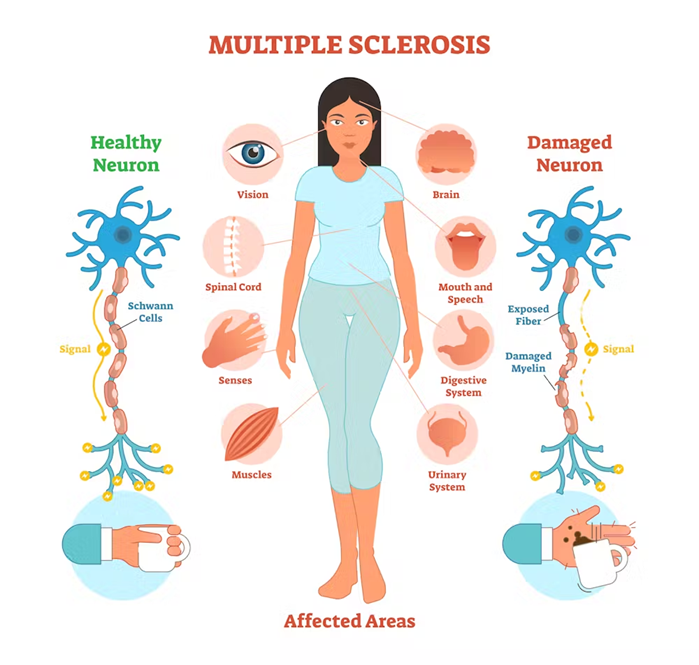 Other Multiple Sclerosis (MS) symptoms include:
Other Multiple Sclerosis (MS) symptoms include:
- vision changes
- fatigue
- weakness
- tingling
- trouble walking or staying balanced
- trouble remembering or thinking
The symptoms of sepsis include:
- severe pain
- a rapid heart rate or weak pulse
- confusion
- fever or chills
- difficulty breathing
- clammy skin
Depending on where cancer has spread, other late-stage symptoms of cancer may include:
- bone pain and fractures if cancer is in the bones
- shortness of breath, if cancer is in the lungs
- headaches and dizziness if cancer has reached the brain
- abdominal swelling and jaundice, which give a yellow tinge to the eyes, if cancer has spread to the liver
How Aches, Pains & Headaches are Diagnosed
If you have pain, your doctor has many ways to find out what’s causing it. They will ask about your symptoms and your medical history, including any illness, injury, or surgery.9
Your doctor will also examine you and may order blood tests or X-rays. Among the tests that can help pinpoint the cause of your pain are:
- CT scan: Computed tomography scans use X-rays and computers to produce an image of a cross-section of the body. During the test, you lie as still as possible on a table. It will move through a large, doughnut-shaped scanning device. Sometimes, your doctor may inject a solution (contrast) into a vein before your scan. It can help make it easier to see what’s going on inside. Most CT scans take 15 minutes to an hour.
- MRI: Magnetic resonance imaging can give your doctor clear pictures of organs and structures inside your body. This test uses a large magnet, radio waves, and a computer to make images. An MRI can take 15 minutes to more than an hour, depending on the number of images made. For certain MRIs, you’ll need a shot of a contrast material to help make clearer images. Because an MRI uses magnets, some people, such as people who have pacemakers, shouldn’t have one.
- Nerve blocks: These tests can treat and diagnose the cause of your pain. Your doctor injects something to numb pain (an anesthetic) into nerve locations. They may use an imaging test to find the best right place for the needle. Your response to the nerve block may help find out what’s causing your pain or where it’s coming from.
- Discography: This test is for people who are considering surgery for their back or neck pain. Doctors also use it when they want to do tests before deciding on a treatment. During this test, a dye is injected into the disk that’s thought to be causing the pain. The dye outlines damaged areas on X-rays.
- Myelogram: This test can also be used for back and neck pain. During a myelogram, a dye is injected into your spinal canal. The test helps identify nerve compression caused by herniated disks or fractures.
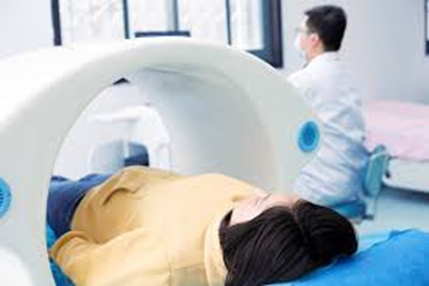 EMG: An electromyogram allows doctors to check muscle activity. Your doctor puts fine needles into your muscles to measure their response to electrical signals.
EMG: An electromyogram allows doctors to check muscle activity. Your doctor puts fine needles into your muscles to measure their response to electrical signals.- Bone scans: These help diagnose and track infection, fracture, or other disorders in the bone. A doctor injects a small amount of radioactive material into your bloodstream. The material will collect in the bones, particularly in areas that aren't normal. A computer then can identify those specific areas.
- Ultrasound imaging: Also called ultrasound scanning or sonography, this test uses high-frequency sound waves to get images of the inside of the body. The sound wave echoes are recorded and displayed as a real-time image.
- Other Tests:
- Physical and neurological examinations.
- Blood, urine, and cerebrospinal fluid tests to check for infections, cancer, and other conditions.
- Reflex and balance tests, diagnostic injections, mobility and strength assessments, and genetic testing.
Types of Aches, Pains & Headaches
There are two types of pain: acute and chronic. Acute pain usually comes on suddenly, because of a disease, injury, or inflammation. It can often be diagnosed and treated. It usually goes away, though sometimes it can turn into chronic pain. Chronic pain lasts for a long time and can cause severe problems.
When it comes to headaches, the most common primary headaches are:
- Cluster headaches
- Migraines
- Migraines with aura
- Tension headaches
- Trigeminal autonomic cephalalgia (TAC), such as cluster headaches and paroxysmal hemicrania
A few headache patterns also are generally considered types of primary headaches, but are less common. These headaches have distinct features, such as an unusual duration or pain associated with a certain activity.
Although generally considered primary, each could be a symptom of an underlying disease. They include:
- Chronic daily headaches (for example, chronic migraine, chronic tension-type headache, or hemicranias continua)
- Cough headaches
- Exercise headaches
- Sex headaches
 Some types of secondary headaches include:
Some types of secondary headaches include:
- Ice cream headaches (commonly called brain freeze)
- Medication overuse headaches (caused by overuse of pain medication)
- Sinus headaches (caused by inflammation and congestion in sinus cavities)
- Spinal headaches (caused by low pressure or volume of cerebrospinal fluid, possibly the result of spontaneous cerebrospinal fluid leak, spinal tap or spinal anesthesia)
- Thunderclap headaches (a group of disorders that involves sudden, severe headaches with multiple causes)
Traditional Medical Treatment for Aches, Pains & Headaches
Pain is not always curable, but there are many ways to treat it. Treatment depends on the cause, location, type and severity of the pain. There are drug treatments, including pain relievers. There are also non-drug treatments, such as acupuncture, physical therapy, and sometimes surgery. Pain is such a prevalent issue there is no shortage of ways to treat it.
Drug Therapy: Nonprescription and Prescription
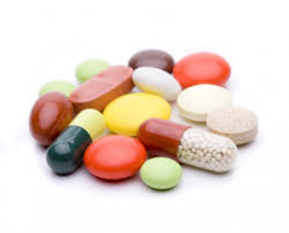 Milder forms of pain may be relieved by over-the-counter medications such as Tylenol (acetaminophen) or nonsteroidal anti-inflammatory drugs (NSAIDs) such as aspirin, ibuprofen, and naproxen. Both acetaminophen and NSAIDs relieve pain caused by muscle aches and stiffness, and additionally NSAIDs reduce inflammation (swelling and irritation). Acetaminophen is often recommended as the first medicine for short-term pain and is unlikely to cause stomach irritation. NSAIDs are for mild to moderate pain but can cause stomach irritation (including bleeding ulcers) with too much use. Topical pain relievers are also available, such as creams, lotions, or sprays that are applied to the skin in order to relieve pain and inflammation from sore muscles and arthritis.10
Milder forms of pain may be relieved by over-the-counter medications such as Tylenol (acetaminophen) or nonsteroidal anti-inflammatory drugs (NSAIDs) such as aspirin, ibuprofen, and naproxen. Both acetaminophen and NSAIDs relieve pain caused by muscle aches and stiffness, and additionally NSAIDs reduce inflammation (swelling and irritation). Acetaminophen is often recommended as the first medicine for short-term pain and is unlikely to cause stomach irritation. NSAIDs are for mild to moderate pain but can cause stomach irritation (including bleeding ulcers) with too much use. Topical pain relievers are also available, such as creams, lotions, or sprays that are applied to the skin in order to relieve pain and inflammation from sore muscles and arthritis.10
If over-the-counter drugs do not provide relief, your doctor may prescribe stronger medications, such as muscle relaxants, anti-anxiety drugs (such as diazepam [Valium]), antidepressants (like duloxetine [Cymbalta] for musculoskeletal pain), prescription NSAIDs such as celecoxib (Celebrex), or a short course of stronger painkillers (such as codeine, fentanyl [Duragesic, Actiq], oxycodone and acetaminophen (Percocet, Roxicet, Tylox) or hydrocodone and acetaminophen (Lorcet, Lortab, and Vicodin). A limited number of steroid injections at the site of a joint problem can reduce swelling and inflammation. An epidural might be given for spinal stenosis or lower back pain.
Sometimes, a group of nerves that causes pain to a specific organ or body region can be blocked with local medication. The injection of this nerve-numbing substance is called a nerve block. Although many kinds of nerve blocks exist, this treatment cannot always be used. Often blocks are not possible, are too dangerous, or are not the best treatment for the problem.
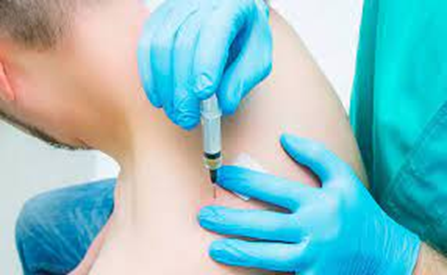 Trigger Point Injections
Trigger Point Injections
Trigger point injection is a procedure used to treat painful areas of muscle that contain trigger points, or knots of muscle that form when muscles do not relax. During this procedure, a healthcare professional, using a small needle, injects a local anesthetic that sometimes includes a steroid into a trigger point (sterile salt water is sometimes injected). With the injection, the trigger point is made inactive and the pain is alleviated. Usually, a brief course of treatment will result in sustained relief.
Trigger point injection is used to treat muscle pain in the arms, legs, lower back, and neck. In addition, this approach has been used to treat fibromyalgia, tension headaches, and myofascial pain syndrome (chronic pain involving tissue that surrounds muscle) that does not respond to other treatment.
Onabotulinumtoxina (Botox) is a toxin that blocks signals from the nerves to the muscles. It can also be injected to alleviate chronic migraine headaches. The procedure involves multiple injections around the head and neck every 12 weeks and may alleviate pain for up to three months.
Surgical Implants
When standard medicines and physical therapy fail to offer adequate pain relief, you may be a candidate for a surgical implant to help you control pain. When they are used, which is rare, there are two main types of implants to control pain:
- Intrathecal Drug Delivery.Also called infusion pain pumps or spinal drug delivery systems. The surgeon makes a pocket under the skin that's large enough to hold a medicine pump. The pump is usually about one inch thick and three inches wide. The surgeon also inserts a catheter, which carries pain medicine from the pump to the intrathecal space around the spinal cord. The implants deliver medicines such as morphine or a muscle relaxant directly to the spinal cord, where pain signals travel. For this reason, intrathecal drug delivery can provide significant pain control with a fraction of the dose that would be required with pills. In addition, the system can cause fewer side effects than oral medications because less medicine is required to control pain.
- Spinal Cord Stimulation Implants.In spinal cord stimulation, low-level electrical signals are transmitted to the spinal cord or to specific nerves to block pain signals from reaching the brain. This method being especially used for back and limb pain. In this procedure, a device that delivers the electrical signals is surgically implanted in the body. A remote control is used by the patient to turn the current off and on or to adjust the intensity of the signals. Some devices cause what’s described as a pleasant, tingling sensation while others do not.
TENS
Transcutaneous electrical nerve stimulation therapy, more commonly referred to as TENS, uses electrical stimulation to diminish pain. During the procedure, low-voltage electrical current is delivered through electrodes that are placed on the skin near the source of pain. The electricity from the electrodes stimulates the nerves in an affected area and sends signals to the brain that "scramble" normal pain signals. TENS is not painful and may be effective therapy to mask pain such as diabetic neuropathy. However, TENS for chronic low back pain is not effective and cannot be recommended, says the American Academy of Neurology (AAN).
Bioelectric Therapy
Bioelectric therapy relieves pain by blocking pain messages to the brain. Bioelectric therapy also prompts the body to produce chemicals called endorphins (endorphins are also released by exercise) that decrease or eliminate painful sensations by blocking the message of pain from being delivered to the brain. Bioelectric therapy can be used to treat many chronic and acute conditions causing pain, such as back pain, muscle pain, headaches and migraines, arthritis, TMJ disorder, diabetic neuropathy, and scleroderma.
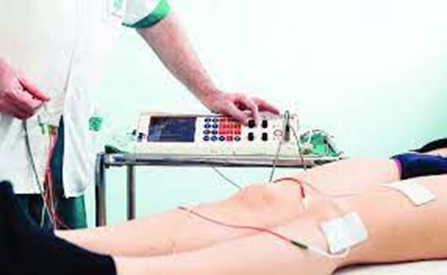 Bioelectric therapy is effective in providing temporary pain control, but it should be used as part of a total pain management program. When used along with conventional pain-relieving medications, bioelectric treatment may allow pain sufferers to reduce their dose of some pain relievers by up to 50%.
Bioelectric therapy is effective in providing temporary pain control, but it should be used as part of a total pain management program. When used along with conventional pain-relieving medications, bioelectric treatment may allow pain sufferers to reduce their dose of some pain relievers by up to 50%.
Physical Therapy
Physical therapy helps to relieve pain by using special techniques that improve movement and function impaired by an injury or disability. Along with employing stretching, strengthening, and pain-relieving techniques, a physical therapist may use, among other things, TENS to aid treatment.
Exercise
Although resting for short periods can alleviate pain, too much rest may actually increase pain and put you at greater risk of injury when you again attempt movement. Research has shown that regular exercise can diminish pain in the long term by improving muscle tone, strength, and flexibility. Exercise may also cause a release of endorphins, the body's natural painkillers. Some exercises are easier for certain chronic pain sufferers to perform than others; try swimming, biking, walking, rowing, and yoga.
Psychological Treatment
When you are in pain, you may have feelings of anger, sadness, hopelessness, and/or despair. Pain can alter your personality, disrupt your sleep, and interfere with your work and relationships. In turn, depression and anxiety, lack of sleep, and feelings of stress can all make pain worse. Psychological treatment provides safe, nondrug methods that can treat your pain directly by reducing high levels of physiological stress that often aggravate pain. Psychological treatment also helps improve the indirect consequences of pain by helping you learn how to cope with the many problems associated with pain. A large part of psychological treatment for pain is education, helping patients acquire skills to manage a very difficult problem.
Alternative Therapies
In the past decade, many people have found relief for their pain in mind-body therapies, acupuncture, and some nutritional supplements. Others use massage, chiropractic and osteopathic (bone) manipulation therapies, therapeutic touch, certain herbal therapies, and dietary approaches to alleviate pain.
 Dietary Approaches to Treating Pain
Dietary Approaches to Treating Pain
Some people believe that changing dietary fat intake and/or eating plant foods that contain anti-inflammatory agents can help ease pain by limiting inflammation. A mostly raw vegetarian diet was found helpful for some people with fibromyalgia, but this study was not methodologically strong. One study of women with premenstrual symptoms suggested that a low-fat vegetarian diet was associated with decreased pain intensity and duration. Weight loss achieved by a combination of dietary changes and increased physical activity has been shown to be helpful for people suffering from osteoarthritis.
Complications of Aches, Pains & Headaches
Chronic pain can interfere with your daily activities, such as working, having a social life and taking care of yourself or others. It can lead to depression, anxiety and trouble sleeping, which can make your pain worse.
Complications from chronic pain include:
- Physical: Fatigue, sleep disturbances, weakened immune system, and decreased mobility
- Cardiovascular: Increased risk of developing hypertension
- Musculoskeletal: Muscle, nerve, and joint weakness
- Hormonal: Uncontrolled chronic pain can negatively affect the endocrine system, causing abnormally high or low levels of hormones
- Neuropsychiatric: Chronic pain may affect brain function and cognitive process, and may lead to issues with insomnia and depression
- Psychiatric: Depression, anxiety, and substance abuse disorders
- Quality of life: Decreased quality of life, reduced productivity, lost wages, and worsening of chronic disease
- Suicidal ideation: Increased risk for suicide and suicidal ideation
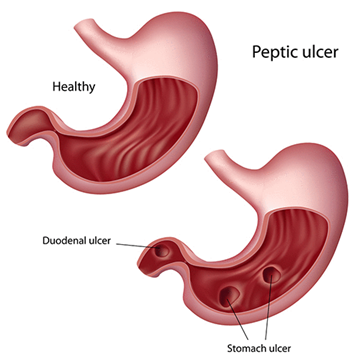 One of the most common things people do when they are in pain is to take over-the-counter pain medicines. In July 2015, the FDA asked that both prescription and over-the-counter NSAIDs strengthen their warning labels to indicate the potential risk of heart attacks and strokes. The risk increases with higher doses of the drugs. In addition, there is also the possibility of developing bleeding stomach ulcers.10 I personally see so much inflammation in the stomach primarily due to over use of pain medications.
One of the most common things people do when they are in pain is to take over-the-counter pain medicines. In July 2015, the FDA asked that both prescription and over-the-counter NSAIDs strengthen their warning labels to indicate the potential risk of heart attacks and strokes. The risk increases with higher doses of the drugs. In addition, there is also the possibility of developing bleeding stomach ulcers.10 I personally see so much inflammation in the stomach primarily due to over use of pain medications.
What Traditional Medicine is Not Telling You About Aches, Pains & Headaches
The information I am about to share with you was not taught to me during any of my medical training. What medical school, internship, internal medicine residency, and my Gastroenterology fellowship taught me was how to diagnose symptoms, prescribe medicines and do amazing colonoscopies and upper endoscopies. What it didn’t teach was the true reason why people are having symptoms to begin with.
As I stated earlier, aches, pains and headaches are so prevalent today there is no shortage in medical treatments, procedures, tests, and advanced therapies to treat it. The problem is those things are just a band-aid, they are not actually fixing the problem. Notice how many of the treatments are to block pain receptors from the brain? That’s right, we are not trying to figure out why the pain is there, we are just trying to block the brain from xknowing about it.
Aches, pains and headaches means inflammation and the type of aches and pains most people are dealing with is inflammation due to toxic build-up. Of course, there are aches and pains from pulling a muscle or exercising too much. I am not going to address that type of pain because that is temporary. I’m going to discuss the aches, pains and headaches that come and go and don’t go away but seem to be getting worse with time.
Three of the big reasons people are suffering from aches, pains and headaches is their body is toxic, they are not hydrating properly and on top of that they are eating the Standard American Diet (SAD) which is full of calories but contains little nutrition. I’ve always said, as a society we are overfed and undernourished. Without the proper nutrition and hydration, it makes it hard for our body to function properly and the first symptoms of this could be aches and pains. Once we start feeling like that, moving the body through exercise becomes a problem because motivation is lost. Not moving the body on a regular basis makes it even harder to remove toxins from the body – it becomes a vicious cycle.
Everything you consume (food, drinks, medicines), everything you put on your body (lotions, makeup, shampoos, deodorants), even the air that you breathe is processed by the body. Your body is constantly being exposed to toxins. Over time, the more we expose ourselves the harder it is for the body to keep up. The more toxic it is, the more aches, pains and headaches we have. For example, consider all the over the counter and prescription medications people are taking. The number of U.S. adults who report taking at least one prescription medication per day is now 70%, a 14 percentage-point increase from 2019 data.11 And this doesn’t even consider over the counter pain medicines, which I know most of my patients take on a regular basis. No matter what medicine you are taking, including pain medicine, it is a toxic chemical you are putting in your body. Keeping our body clean is critical for reversing aches, pains, and headaches. More on the importance of detoxification later.
 Now consider the Standard American Diet (SAD), loaded with processed foods, fast foods, fancy coffees, and energy drinks. All these items are filled with chemicals, preservatives, dyes, sugars, and even worse, artificial sugars, items our body doesn’t even know what to do with much less process properly. Imagine the damage being done to the body as it works hard to process these items.
Now consider the Standard American Diet (SAD), loaded with processed foods, fast foods, fancy coffees, and energy drinks. All these items are filled with chemicals, preservatives, dyes, sugars, and even worse, artificial sugars, items our body doesn’t even know what to do with much less process properly. Imagine the damage being done to the body as it works hard to process these items.
Finally, we drink everything but water and think that just because it’s liquid, it’s hydrating us. Or if you are smart enough to drink a good amount of water per day most people are just drinking plain water from bottles or their refrigerator. If you haven’t learned anything else from reading this eBook, please learn this - the only thing that hydrates the body is water and not all water is created equal.> It’s time to learn more about alkaline water with electrolytes because it is key to hydrating properly and completely, in addition to cleaning out the body as quickly as possible. More on this later as well.
The best way to reverse aches, pains and headaches is to get to the bottom of your symptoms to eliminate prescription and over-the-counter medicines, regularly detox the body, and drink more alkaline water with electrolytes.
Why it’s Important to Detoxify Your Body
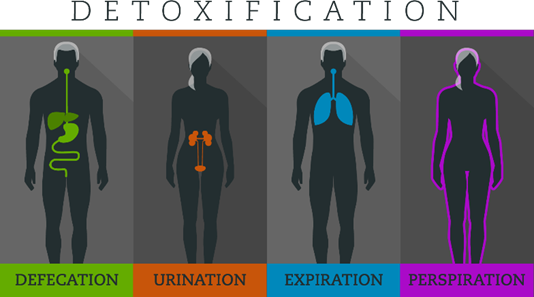 If you had asked me 15 years ago about the importance of detoxing the body, I would have referred you to a naturopathic doctor, but today it is my favorite topic to discuss. As a Gastroenterologist one of my favorite organs (the colon) is responsible for much of that detoxification. Our body has many natural mechanisms for detoxing, for example urine, stool, sweat, and breath. As we age, our body slows down, and we aren’t detoxing like we should. Over time, as our body slows down, we hold on to more of these toxins making us experience aches and pains (especially headaches).
If you had asked me 15 years ago about the importance of detoxing the body, I would have referred you to a naturopathic doctor, but today it is my favorite topic to discuss. As a Gastroenterologist one of my favorite organs (the colon) is responsible for much of that detoxification. Our body has many natural mechanisms for detoxing, for example urine, stool, sweat, and breath. As we age, our body slows down, and we aren’t detoxing like we should. Over time, as our body slows down, we hold on to more of these toxins making us experience aches and pains (especially headaches).
I have patients in their early 20’s that are experiencing these issues because this is a generation of kids of that have lived off processed foods, fast foods, energy drinks, fancy coffees, recreational drugs, vapes, etc. Imagine the toxins their bodies take in every day and even though they are young, their body can’t keep up.
Our body is a healing vessel, it wants us to be well, but when we continue to expose it to toxins day in and day out, it can only do so much. At some point it’s going to throw up its hands and say, “enough is enough, you’re on your own!” This is when symptoms like aches, pains, tiredness, low energy, foggy brain, set in. And unfortunately, when this happens the pharmaceutical and food industry will tell us to take pain meds or drink more caffeine. I have several friends that haven’t been to their doctor in decades because they say they “feel fine” yet are drinking energy drinks and taking pain meds every day for one reason or another. In the end, adding more toxicity to the body - it truly is an endless cycle.
The bottom line is, we are all moving in the same direction, it just depends on how fast you want to get there. Keeping a clean body is one way to slow the process of aging, it can also help you get off unnecessary prescription and over the counter medicines and most importantly reverse those aches and pains.
Why Hydrating Properly is So Important
The most important thing you can do for your body daily is to drink water. The only thing that hydrates the body is water – everything else dehydrates the body (juices, caffeinated drinks, energy drinks, sodas, lemonade, iced tea, alcohol, etc.) Just to replenish what you lose daily; you need to drink half of your body weight in ounces of water per day. This means if you weigh 200 lbs. you should be drinking 100 ounces of water per day. And if you drink that cup of coffee or two every day (which is caffeine, which is a diarrhetic so it’s going to make you urinate), you need even more water to compensate. Most people do not drink the recommended amount of water every day and wonder why they don’t feel good. Out of all the advice we’ve given patients over the years, this is the one piece of advice patients have mentioned that made the biggest impact on them – that was to drink more water. The more water you drink and the less of everything else you drink, the healthier the body is going to be.
 For aches and pains to go away (even headaches) the toxicity must be washed away. The best way to do this is by drinking water. Drinking water is the best way to detoxify the body. And if you want to take your water drinking to the next level you need to consider drinking alkaline water. Especially if you’re the type of person who doesn’t drink a lot of water because it makes you pee a lot. Alkaline water will absorb deeper into the body, detoxing you better and hopefully causing you to pee less often. To learn what alkaline water is and how it works be sure to check out the next section on my approach to aches and pains.
For aches and pains to go away (even headaches) the toxicity must be washed away. The best way to do this is by drinking water. Drinking water is the best way to detoxify the body. And if you want to take your water drinking to the next level you need to consider drinking alkaline water. Especially if you’re the type of person who doesn’t drink a lot of water because it makes you pee a lot. Alkaline water will absorb deeper into the body, detoxing you better and hopefully causing you to pee less often. To learn what alkaline water is and how it works be sure to check out the next section on my approach to aches and pains.
Finally, let’s discuss water additives, especially electrolytes. The big thing in the last couple of years are flavored powders or liquids that can be added to water to give it some taste while at the same time adding some extra vitamins, minerals and sometimes energy boosters to the body. People may use these because they feel water doesn’t have a taste, or they think it’s boring to drink water, or maybe they are trying to supplement something in the diet or give themselves that extra boost they feel they need to get through the day. Let me be clear, most of the powders and liquids on the market today are loaded with chemicals, artificial flavors, artificial sugars and preservatives. Even the ones that say no sugar added, nine times out of ten they will have artificial sugar which is worse for you than regular sugar. I guarantee these are only contributing to your problem, not solving it.
The thing you do need is electrolytes. Electrolytes are salts that are responsible for keeping the body properly hydrated so the muscles and nerves can function properly. The human body is composed mostly of salt water. Have you ever tasted your sweat or your tears? They are salty! Your body is a giant saltwater bag and all day long you are losing salt water, when you urinate, when you sweat or when you talk. If you do not replace this salt water your body becomes very dehydrated (again, a key symptom of aches, pains and headaches). Most people who are drinking water are not drinking water with electrolytes. Some might be drinking things like Gatorade, Powerade, etc. but again those drinks are loaded with chemicals, sugar, artificial sugar, preservatives, and dyes. The bottom line, they are not helping the body but hurting it. There is a solution for a good pure, clean, electrolyte powder to use in your water. The next section on my approach will explain it in further detail.
And if you still think water doesn’t taste good, consider adding fresh vegetables or fruit to your water. This is a natural way of flavoring your water without needing store bought products that will add toxicity to the body. Some ideas include lemon, lime, cucumber, watermelon, blueberries, strawberries, etc.
A Different Approach to Aches, Pains & Headaches
In 2007, I approached my wife and Office Manager Tina and told her how frustrated I was with medicine. I was running all the tests, doing all the procedures, and prescribing all the medicines and could not figure out why my patients were still hurting. That frustration led us on a two-year journey to learn what my medical degree did not teach me about the body and how it works, in addition to what is happening in the medical industry, pharmaceutical industry and food industry to cause so many health problems in our society.
After we learned what we did, we felt obligated to share this with our patients and we’ve been doing so since 2010. Tina was so passionate about what we learned, she went back to school and received her Certificate in Holistic Nutrition so she could help me deliver this message to as many people as we possibly could. Since we started on this journey, we have helped tens of thousands of patients and wellness clients eliminate their symptoms naturally, helping their bodies work again like they were meant to work. And the best part of it all, is it’s not as hard as you may think to turn it all around, no matter how long you’ve been suffering or how old you are. If you are willing to put in the time, effort and invest in yourself, you can have your life back too.
Aches, pains and headaches are so prevalent today but the great thing about it is they can be reversed. Although lifestyle changes are important for this to occur there are some other ways to help speed the process up. Below is the plan I use with my patients that helps get to the bottom of their issues so we can detoxify and rebuild the body as fast as possible.
Details on this approach are as follows:
 A Cellular Level Food Sensitivity Test – Anyone suffering from aches and pains absolutely must get this test done. There could be foods that you are eating on a regular basis that your body does not agree with and are causing you problems. Instead of elimination diets and the guessing game, this test will identify the foods that are causing you problems so we can get you off those foods temporarily, allowing the gut to heal. Once this is accomplished, food sensitivities are eliminated, you can reintroduce these foods back into your diet.
A Cellular Level Food Sensitivity Test – Anyone suffering from aches and pains absolutely must get this test done. There could be foods that you are eating on a regular basis that your body does not agree with and are causing you problems. Instead of elimination diets and the guessing game, this test will identify the foods that are causing you problems so we can get you off those foods temporarily, allowing the gut to heal. Once this is accomplished, food sensitivities are eliminated, you can reintroduce these foods back into your diet.
- Traditional allergists run skin and blood tests to determine food allergies. This food sensitivity test goes a level deeper to study the cellular level of the body, the difference between a food allergy and a food sensitivity.
 Intestinal Permeability Test – This test will assess your urine to determine if there are microscopic tears “leaky gut” in the small bowel which allow partially digested food particles, viruses, bacteria, and toxins to enter the blood stream. This can lead to inflammation and changes with the gut bacteria that affect your gut health. Leaky gut is the number one cause of gas, bloating, and food allergies / sensitivities. It typically goes untreated because there is no traditional medical test to diagnose it.
Intestinal Permeability Test – This test will assess your urine to determine if there are microscopic tears “leaky gut” in the small bowel which allow partially digested food particles, viruses, bacteria, and toxins to enter the blood stream. This can lead to inflammation and changes with the gut bacteria that affect your gut health. Leaky gut is the number one cause of gas, bloating, and food allergies / sensitivities. It typically goes untreated because there is no traditional medical test to diagnose it.
- When leaky gut is diagnosed, with the right treatment plan, it is one of the easiest things to recover from. Healing leaky gut is the most essential component to a healthy digestive system.
- Protease Enzymes / Detoxifying Daily – Proteolytic enzymes, also called protease, break down proteins in the body. If you are familiar with digestive enzymes you know that protease is just one of many enzymes that help break down the food we eat on a daily basis. However, protease enzymes go even further by helping to break down proteins throughout the whole body. The formulation of protease enzymes found in our Delicate Detox™ is designed to work only in the blood (on the whole-body level) instead of just in the stomach. What good do protease enzymes do in the blood; you may ask? Well, just about everything that makes us sick is either a protein or is protected by a protein.
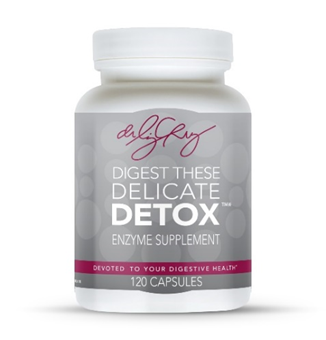 Bacteria, viruses, yeasts, and fungi are all protected by proteins. In addition, cancer cells are protected by proteins. Food allergens are also proteins. Many food allergies come from us not digesting our food well enough.
Bacteria, viruses, yeasts, and fungi are all protected by proteins. In addition, cancer cells are protected by proteins. Food allergens are also proteins. Many food allergies come from us not digesting our food well enough. - If we don’t have the proper digestive enzymes to break down our food daily and our food enters our small bowel partially digested, large protein molecules can get absorbed into the blood stream. This causes your immune system to kick-in and antibodies are formed with proteins to “protect” the body. Circulating Immune Complexes (CIC’s) are then formed. Basically, this means that your body has now created an immune response “tagged” to something that it shouldn’t. When this happens over and over, the body “stores” these “tags” into its own tissue, because it is now overwhelmed with trying to eliminate them through urination and sweat. This is why the body attacks its own tissue at times, as seen in diseases like lupus and rheumatoid arthritis. Supplementing with a proteolytic enzyme can help break down CIC’s, so that they can be passed through urine or sweat easily.
- The blood not only carries oxygen and nutrients throughout the body, it’s also a way for cells and organs to dispose of their garbage and dead material. One way to cleanse the blood is taking a protease enzyme supplement, which can break down things that would otherwise compromise the immune system.
- In addition, these proteolytic enzymes can improve circulation by eating excess fibrin. Fibrin is a strong protein responsible for the development of blood clots. Excess fibrin makes the blood thick, which is a dangerous situation.
- As a result of cleaning out the blood the following can occur; inflammation is reduced, blood flow is optimized, blood clots are prevented, allergies are minimized, arterial plaque is dissolved, headaches are minimized, and cardiovascular health is optimized. Which is why when people start taking the Delicate Detox™ they are able to start fixing more than just their digestive system.
- There are not many supplements on the market that compare to our Delicate Detox™. Not only are they unique, but they are also what I like to call medical grade (high potency and no fillers). This is important when taking a supplement, especially protease enzymes. It is meant to be taken on an empty stomach. I usually take 2 when I wake up and 2 before going to bed.
- Alkaline Water – Remember how I stated above, “not all water is created equal”. Alkaline water is what I was referring to. If you are suffering from aches and pains, drinking more water is important but drinking alkaline water can take your health to the next level. The “alkaline” in alkaline water refers to its pH level. A pH level is a number that measures how acidic or alkaline a substance is on an approximate scale of 0 to 14. For example, something with a pH of 1 would be very acidic, and something with a pH of 13 would be very alkaline. Regular drinking water generally has a neutral pH of 7. Alkaline water typically has a pH of 8 or 9.
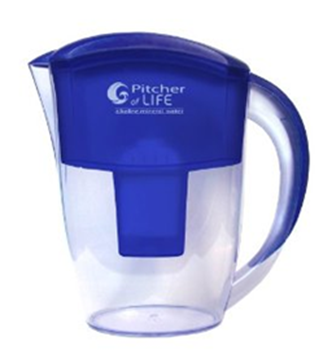 Just like a fish tank or a swimming pool, our body needs to maintain a certain pH to stay healthy. If we get really sick and are in the hospital, our pH is monitored because if it drops below a certain amount we can die. When we are healthy, we don’t pay much attention to our pH, but that doesn’t mean it’s not important. On the pH scale, our body is slightly alkaline, so anything you can do to drink and eat more alkaline makes it easier for your body to maintain its alkalinity and in turn work to keep you healthy.
Just like a fish tank or a swimming pool, our body needs to maintain a certain pH to stay healthy. If we get really sick and are in the hospital, our pH is monitored because if it drops below a certain amount we can die. When we are healthy, we don’t pay much attention to our pH, but that doesn’t mean it’s not important. On the pH scale, our body is slightly alkaline, so anything you can do to drink and eat more alkaline makes it easier for your body to maintain its alkalinity and in turn work to keep you healthy. - Your body is a healing vessel, it wants you to be well. Sometimes we just need to help it out a little. Drinking alkaline water is one simple thing you can do to help your body out. It’s especially helpful for people who need to detox the body because it allows more water to absorb into the cells.
- Electrolytes – Electrolytes are critical to our health. They are the pathways our cells use to communicate with each other. Without electrolytes our body is dehydrated. There are so many health symptoms that come from dehydration, aches and pains being one of many.
 Our Electrolytes are called Super Salts™. They contain the four key electrolyte salts that are made up in the body allowing the body to replenish exactly what it is losing daily. Super Salts™ are meant to be put in water, not on food.
Our Electrolytes are called Super Salts™. They contain the four key electrolyte salts that are made up in the body allowing the body to replenish exactly what it is losing daily. Super Salts™ are meant to be put in water, not on food. - Our Super Salts™ are different from other electrolyte powders or water additives on the market because they have zero preservatives, sugars, or artificial sugars. This is important because many of those additives can cause digestive issues and toxicity in the body. When you take a supplement like this, the goal is to get well, not cause more issues – the cleaner the product you are consuming, the better.
- We suggest putting one scoop of salts (1 teaspoon) in every 26 – 32-ounce bottle of water you drink. If you cannot do this because it is too salty tasting, start by adding ¼ scoop of salts to 26 – 32 ounces of water and then increase from there once you get used to it. Ideally you want to be drinking about 2 – 3 scoops of salt per day.
Act Now – 3 Options to Move in the Right Direction
Depending on your level of commitment and interest in turning around your aches and pains, there are three options to consider:
- Good – if you want to start slow and are not sure if this is for you, at least order our Delicate Detox™ and Super Salts™. The investment is minimal and it’s not hard to incorporate these two supplements into your daily routine to see if they can help. I do encourage you to try this regimen for at least 3 months before you decide it’s not working for you. Doing something for only a few days or even a month is not going to make a huge difference in your body, especially if you’ve been struggling with aches, pain and headaches for a long time.
- Better – if you are ready to make a more serious commitment to turning around your aches, pains and headaches and have some money to invest in yourself, consider ordering our Aches / Pains / Migraines Starter Kit. It includes three months’ worth of our Delicate Detox™ and Super Salts™, along with an Alkaline Water Pitcher so you can start benefiting from alkaline water right away. In addition, it also comes with the Cellular Level Food Sensitivity Test and the Intestinal Permeability Test I explained above. By purchasing the kit, you get all these items at a discounted rate so it’s much better than buying them individually.
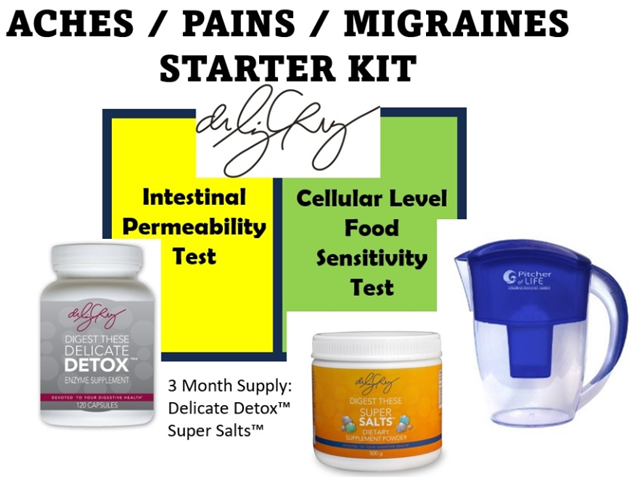
- Best – if you have money to invest in yourself, are suffering from other medical issues and you’re sick and tired of feeling sick and tired consider going all in on our Digestive Revolution™ Ultimate Plan. This is my 4-Step Proprietary System which is an outcomes and scientific based system that starts at the cellular level. The system delivers 4 main outcomes:
- 1. Eliminates digestive issues such as gas, bloating, constipation, diarrhea, and acid reflux.
- 2. Removes pain and inflammation from the body.
- 3. Reduces the need for prescription and over-the-counter medications.
- 4. Increases energy, enhances sleep, and the ability to get to your healthy base weight.

No matter what you decide to do, do something! You get sick and remain sick by accident – you get healthy on purpose!
References
- [1] Forbes Article - https://www.forbes.com/sites/omerawan/2024/02/25/more-than-1-in-5-americans-experience-chronic-pain-heres-what-to-know/?sh=489ba9036c9e
- [2] US Pain Foundation - https://uspainfoundation.org/news/the-impact-of-pain-in-america/
- [3] International Association Study for Pain - https://journals.lww.com/pain/abstract/2022/02000/prevalence_of_chronic_pain_among_adults_in_the.31.aspx#:~: text=Using%20a%20chronic%20pain%20module,%2C%20knee%2C%20or%20foot%20pain.
- [4] National Library of Medicine - https://pubmed.ncbi.nlm.nih.gov/34749638/#:~:text=Background%3A%20Headache%20affects%2090%2D99,have%20never%20experienced%20a%20headache.
- [5] Medline Plus - https://medlineplus.gov/pain.html
- [6] Mayo Clinic - https://www.mayoclinic.org/symptoms/headache/basics/definition/sym-20050800#:~:text=Headache%20is%20pain%20in%20any,or%20have%20a%20viselike%20quality.
- [7] Health Line - https://www.healthline.com/health/body-aches#stress
- [8] Mayo Clinic - https://www.mayoclinic.org/symptoms/headache/basics/causes/sym-20050800
- [9] Web MD - https://www.webmd.com/pain-management/pain-management-diagnosing
- [10] Web MD - https://www.webmd.com/pain-management/pain-management-treatment-overview
- [11] Civic Science - https://civicscience.com/a-growing-number-of-americans-report-taking-prescription-medications-daily/#:~:text=Recent%20CivicScience%20poll%20results%20reveal,point%20increase%20from%202019%20data.
These statements have not been evaluated by the Food and Drug Administration.
These products are not intended to diagnose, treat, cure, or prevent any disease.

Liz Cruz, MD
- Award-winning, board-certified gastroenterologist
- Sought-after leader in solving complex digestive health conditions
- 30+ years of dedicated patient service
- Best-selling author, podcaster and international speaker
Dr. Liz Cruz was named Top Gastroenterologist in 2019. She is a Diplomat of the American Board of Internal Medicine and the American Board of Gastroenterology. Dr. Cruz is a member of the American Gastroenterological Association, American College of Gastroenterology, and the American Society for Gastrointestinal Endoscopy. In 2014, she received the Quilly Award from the National Academy of Best-Selling Authors® for her Best-Selling Book “Answering the Call".
